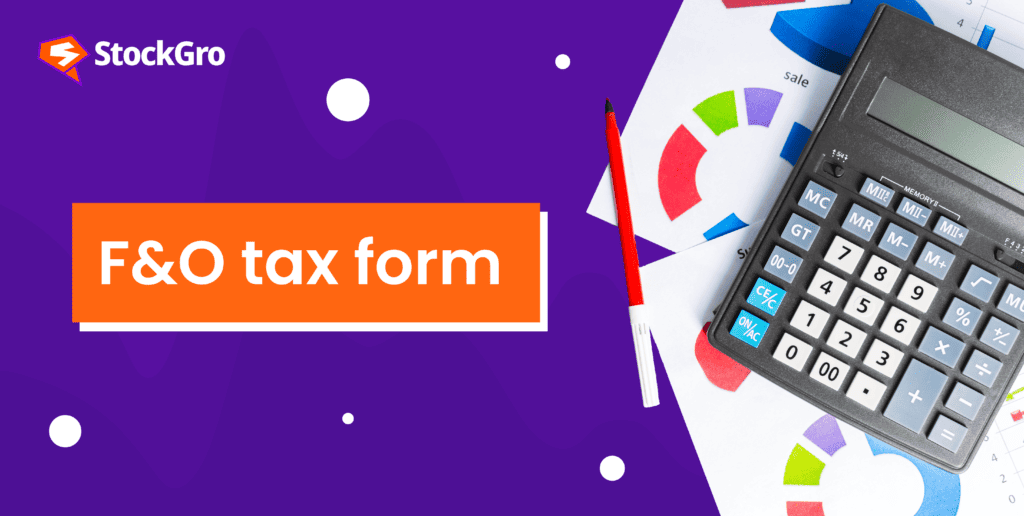
One of the main tools used in derivatives trading is futures and options contracts. To the layman, derivatives are contracts whose value is based on underlying assets or groups of assets. These assets might be currencies, commodities, equities, bonds, or market indices.
Trading options and futures have a high degree of risk and complexity. Numerous aspects, including alterations to interest rates, fluctuations in markets, and exchange rate trends, can impact the value of these derivatives.
Securities, currency, and commodity trading in the futures and options markets are taxable; however, many small investors do not know how to show F&O losses in ITR filing, because of which they exclude this component. Let’s look at the key things to remember regarding the implications of tax on futures and options.
You may also like: Futures vs. Options: Differences every investor must know!
Understanding tax on F&O trading
Many people find it challenging to file income tax returns regarding any income earned through trading options and futures markets. Most transactions involving futures and options are relatively large and frequent, providing little profit.
Trading futures and options can result in financial gains and losses that must be reported as business earnings and expenses on the ITR-4 tax form. Post-deduction taxable income is subject to taxation as well.
Non-speculative income
To begin with, earnings from trading futures and options are classified as non-speculative revenue under income tax regulations.
A transaction not dependent on the delivery of any product, such as stocks or other assets, is called speculative income. For example, traders who purchase and sell stocks on the same day without delivery to the demat account are said to be making speculative money on intraday equities transactions.
However, since it’s believed that traders take advantage of this section for hedging, income from F&O is classified as non-speculative.
Requesting a cost deduction
Investors may deduct trading-related costs as they report futures and options income as business income. In these situations, traders typically have to pay a brokerage charge, loan interest costs, or costs associated with consulting experts. When they file their IT returns, they are able to deduct all of these costs.
Due to the fact that it is commercial income, the investor is able to deduct costs related to F&O trading. Additionally, equipment purchased for trade may be written off.
Report as business earnings
The ability to deduct expenses incurred for company purposes is one of the best parts of filing income tax returns as a business. F&O trading profits and losses must be recorded as business revenue. So, the tax rate on futures and options in India is in accordance with the income tax slabs
This regulation does not, however, apply if investors make only two or three trades in the course of the fiscal year.
It is possible for individuals who file business returns to deduct costs from their income. The total income is calculated by adding the income from the remaining headings, and it is taxed at the individual’s proper slab rates. Special tax rates will be applicable if the taxpayer chooses to use Section 44AD’s presumptive taxation option.
Additionally, rather than submitting ITR 1 or 2, which are typically used for normal tax filing, traders are now required to choose the ITR-3 form. This is because the earnings are now treated under the business category.
Also read: How much tax do you pay on stock market gains?
Options and futures trading income: which ITR to file?
ITR-3 forms must be submitted in regard to the F&O taxation. You will need to submit an ITR-4, however, if you reported profits at 6% of your entire revenue and adhered to a presumptive tax plan. The ITR form you must complete, nevertheless, will also rely on your other revenue sources.
You must use forms ITR-3 or ITR-4 to file your F&O income tax return. For people and Hindu Undivided Families (HUFs) with income from business gains, the ITR-3 is used. For taxpayers who have earnings from investing in futures and options, ITR-3 is the appropriate form since this type of revenue is regarded as business income.
However, ITR-4 is intended for those with presumptive revenue from business or their profession, including individuals, HUFs, and corporations, apart from Limited Liability Partnerships (LLPs). You can use ITR-4 to file your income tax return if you choose to use the presumptive taxation system under Section 44AD of the Income Tax Act.
This is also applicable if you earn profits from trading in F&O. It is significant to remember that taxpayers with income from futures and options trading are not eligible to file ITR-1 or ITR-2 forms. You might face legal repercussions or have your tax return rejected if you file your ITR on the wrong form.
New tax regime for F&O trading
Section 115BAC of the Income Tax Act allows traders who receive revenue from F&O trading to choose the new tax system. The following are crucial things to remember if the F&O trader chooses the new tax regime:
- Calculating tax liabilities should be done using the slab rates included in the new tax system.
- A trader cannot assert deductions in Chapter VI-A
- The trader is unable to deduct any anticipated business losses
- The trader is unable to defer the company loss to subsequent years
- A trader with business income who chooses the new tax regime but has the option to revert to the previous one must complete Form 10IE on the income tax website.
F&O traders are not permitted to deduct their brought-forward business losses from their incomes if they choose to use the new tax regime. Moreover, the company loss cannot be carried over to subsequent years.
Also read: Old vs. New – Which income tax regime is better for FY 2023-24?
Conclusion
Financial instruments that investors may utilise to generate profits or serve as a hedge against their current assets include futures and options. If you trade intraday, make sure that you report all of your earnings and expenses when you file your income taxes to keep the IT department from fining you and sending you notices.

